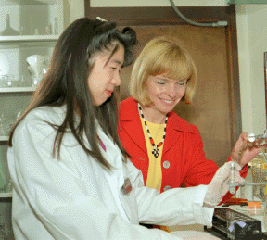


Susan Mao (left) spent a summer working in LBL biologist Priscilla Cooper's lab as part of an LBL education program.
EACH YEAR, MORE THAN 700 GRADUATE AND UNDERGRADUATE STUDENTS from the adjacent University of California's Berkeley campus come to LBL to participate in research projects. More than 240 senior staff scientists at LBL hold faculty appointments at UCB, and LBL also has collaborations with other UC campuses and with many other public and private universities across the nation and around the world.
However, LBL's educational efforts are not limited to college level students alone. In recent years, the Laboratory has been at the forefront of new science education programs that reach out to school children of all ages, supplying scientific training to Bay Area school districts and providing local teachers with up-to-date knowledge and methods for teaching math and science.
LBL is also a member of the Science Education Academy of the Bay Area (SEABA), and a contributor to the "New Explorers Program," a public television series about modern science. Working with teachers, LBL scientists helped develop tapes that serve as teacher guides to two of the programs in the series: "Spiral of Silence," a DNA study of deafness for a family in Costa Rica; and "Restless Earth," a study of earthquakes.
LBL also co-sponsored, along with the National Science Foundation and the Department of Energy, a program called the "National Teacher Enhancement Project." Twenty San Francisco Bay Area science teachers participated in the project's first year where the focus was on environmental studies, specifically groundwater contamination. The program included trips for teachers to LBL laboratories, plus workshops and lectures led by distinguished researchers in the field.
In addition to the efforts of CSEE, LBL has participated for the past 11 years in a consortium with Jackson State University in Mississippi and the Ana G. Mendez University System in Puerto Rico. This consortium is designed to advance the science and technology curriculums at the two schools. LBL is also the host institution for the Hands-on Universe Program. This innovative program allows high school students to link computers in their classrooms with computers at telescopes operated by UC Berkeley's Astronomy Department in order to retrieve astronomical images. Students at Oil City High School in Pennsylvania used the program to good advantage this past spring when they made the preliminary sightings of what were later confirmed by LBL scientists to be three new supernovas.
This past year also saw the Departments of Energy and Education form an unprecedented compact in response to a major educational goal set forth by President Clinton and the nation's governors. The goal calls for "American students to be the first in the world in mathematics and science." At the first joint meeting of the two agencies in September, LBL Director Charles V. Shank was named a co-chair of the committee charged with developing strategies under which the Department of Energy's national laboratories and the Department of Education's regional education laboratories can work together to help attain that goal.

Return to the Table of Contents of the 1994 Regents Report
